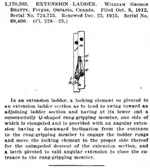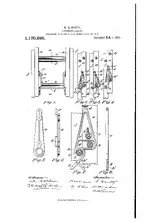Rocsteddie asked:
"that pat[ent] date can be decieving as to when it was made right?"
Yes. The date tells when the Patent was granted/issued. It gives legal protection against somebody copying your invention. For US patents on most things, the protection period is 17 years. Objects are manufactured with the Patent marking for the 17-year life of the patent. Put simply, an object marked "Patented 1916" could have been made during the year 1933. Also, sometimes a Patent gets renewed, which further extends the time-period of the marking.
Some minor corrections to the above, and some additional info:
Technically, a patent only gives its owner the affirmative right to deny others the ability to build the invention for a set period of time, typically 17 years (though it could be less, depending..) So, it's not "legal protection", per se. As a patent owner, you still have to track down infringers and fight with them. You do have the right to stop infringing imports at the border, though. But again, that's an affirmative right, not protection. You still have to duke it out.

As to the patent date, for most articles, this will be within a few years of when it was filed with the patent office. The duration varies by Art Group, with crowded groups often taking longer to get a patent. By "crowded", I mean that the invention generally has been beat to death and it's very hard to come up with something new, useful, and non-obvious - which are the keys to getting anything patented. For example: barbed wire. In this day and age, it would be very difficult to sucessfully prosecute a new patent application in that art group. You could argue for years with the patent office..
Also, it's entirely possible (though I can't think of any examples off-hand), where something was held as a Trade Secret (which is another form of Intellectual Property). The owner of a Trade Secret could file for patent protection years after the invention was "invented", so long as the know-how behind it is not then in the public domain, i.e., still new, useful and non-obvious (and also not in a restricted class - but that discussion gets into the weeds).
Generally speaking, I would think for most common articles, the earliest date you could dig something up would be within a few years (1-6?) of the date it is stamped with its patent #. There will be some exceptions, of course.







